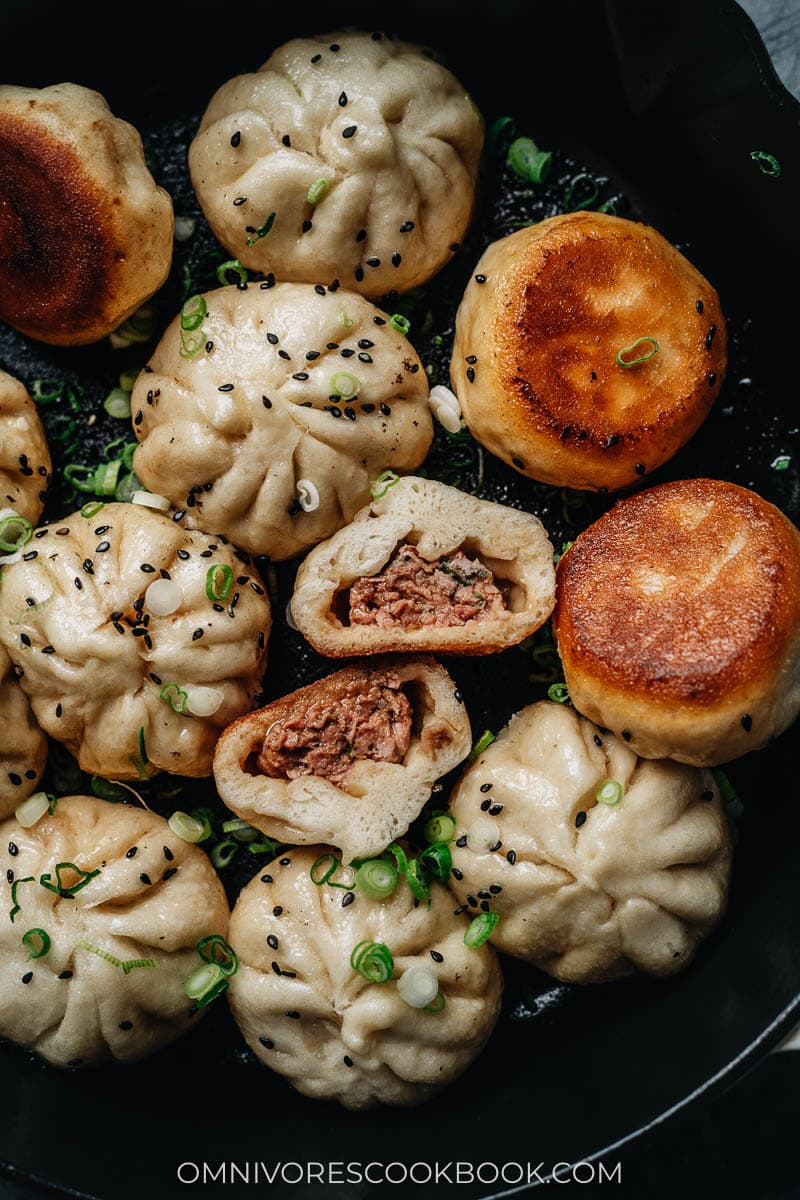
What is Sheng Jian Bao
Sheng Jian Bao (生煎包), or directly translated as raw fried buns, is one of the signature dishes from Shanghai. By “raw”, it means you pan fry the buns without steaming them first, in which process the dough will rise and the bottom crisp up at the same time. The pan-fried pork bun is different from the steamed stuffed buns (known as ‘baozi’), which is steamed only.
The filling is savory pork and green onion with a soupy texture. Imagine crispy potstickers, soup dumplings, and fluffy bread all combined together! One bite into it, and it awakens your taste buds with all the different textures and a rich umami.
Since the 1900s, the people of Shanghai have enjoyed this tasty bun for breakfast, and now you can enjoy it at any time you like in your own kitchen.

Why this recipe
No gelatin required yet very juicy
While many recipes for sheng jian bao use pork gelatin to create a soup-dumpling-like texture, it’s a time-consuming process. It requires pork skin or trotters, braised for many hours to get a rich soup, then chilled overnight.
Plus, the yeast buns tend to absorb the soup during and after cooking, so they don’t even come out soupy.
This version I have for you uses ginger-soaked water to increase the moisture in the filling so you get a juicy texture, yet it simplifies the cooking process. You can make it even juicier than that by using a fattier ground pork, like the type with 30% fat.
Once cooked, the Sheng Jian Bao will have a very juicy and almost soupy filling.
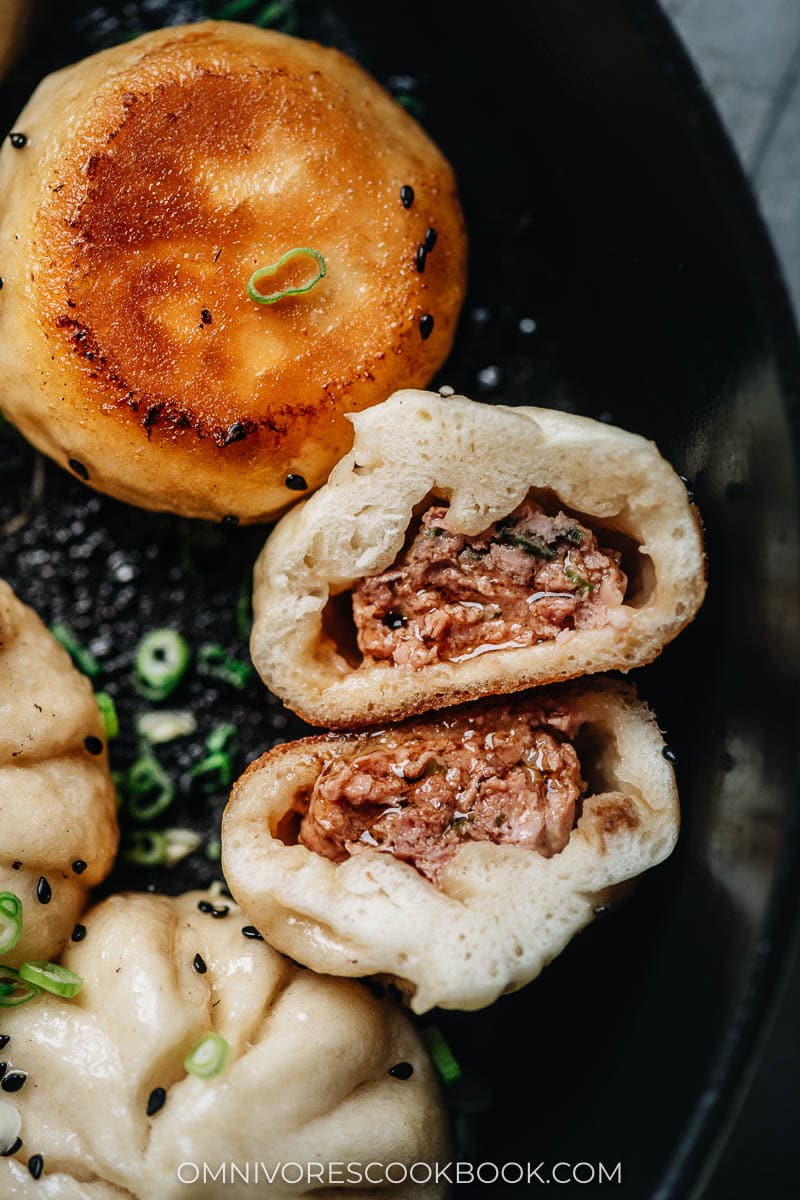
Also, you should know there are two ways to fry these sheng jian bao buns. The first method is to fry them pleat-side down. Or you can go with the flat-side down. I prefer using the latter method because it keeps the pleats pretty for a nice presentation and appearance.
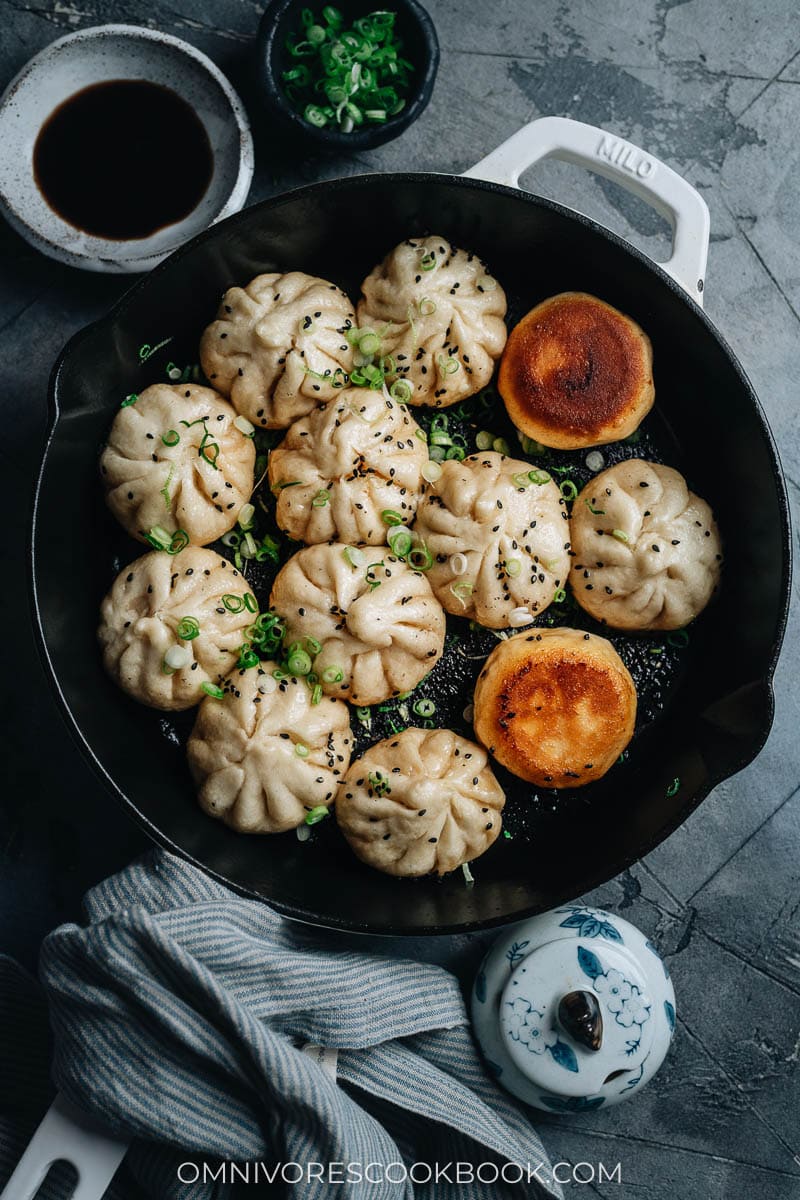
Ingredients
The best part of making Sheng Jian Bao at home is that it requires very basic ingredients you probably already have in your pantry.
NOTE: you will need to use instant yeast instead of dry active yeast. Because the yeast dough is a bit finicky when pan frying and steaming. Using instant yeast produces a more consistent result.
I listed the ingredients below just so you can see everything. When you make the dish, you don’t need to lay everything out in small plates.
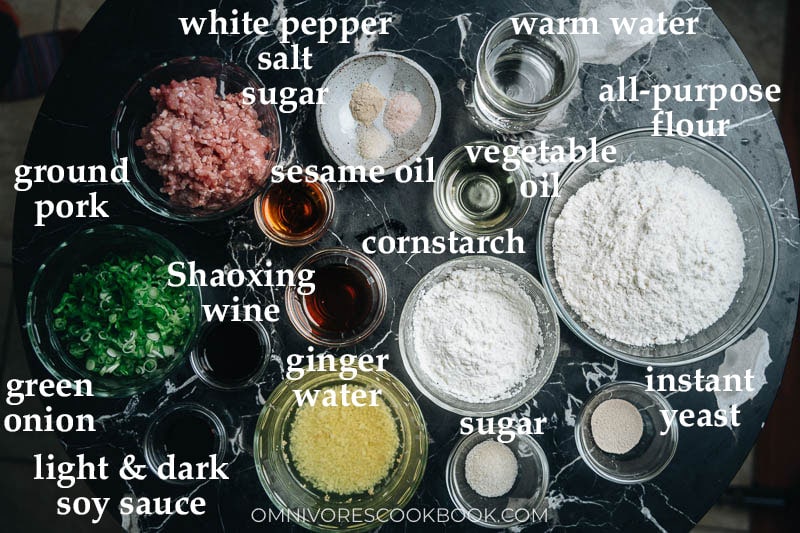
Cooking process
If you’ve made dumplings in the past, you’ll find the cooking process very straightforward. Even for a beginner, the dough is easy to put together. You don’t even need a stand mixer!
To prepare the dough and filling
- Combine all the dry ingredients
- Slowly add warm water and mix until the water is incorporated
- Knead by hand for 15 to 20 minutes
- Cover the dough with plastic wrap and let rest for 1 hour
- Mix the filling ingredients together and beat until sticky
- Add the green onion and sesame oil at the end, mix again. Cover and refrigerate until ready to use
- The dough is ready when the size doubles
- Gently knead for a minute to press out the air bubbles
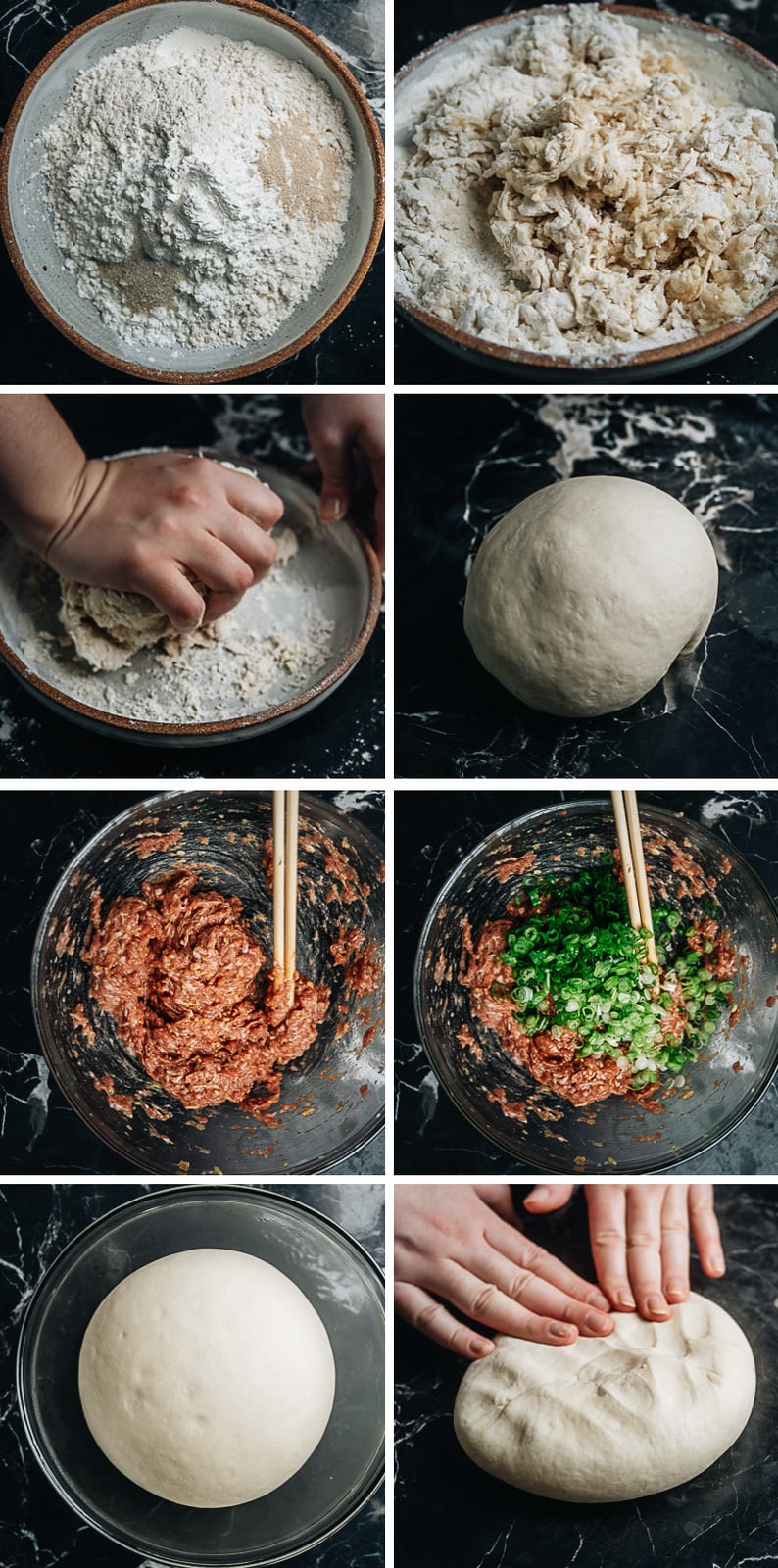
Assemble the buns
I highly recommend working on half a batch of buns at a time, so the dough won’t dry out and the filling won’t get soggy.
- Once you cut the dough in half and reserve the other half, make the half batch of dough into 12 pieces (see the video below for the detailed dough shaping method)
- Flatten the dough
- Roll it into a round disk
- Place 1 tablespoon of the filling onto the disk
- Start wrapping by folding the edges
- Keep folding until the bun is almost sealed
- Pinch together the top
- Slightly twist and seal
- Let the buns rest for 10 minutes before cooking
- Fry the buns to crisp up the bottom
- Add water and cover, to steam the buns
- Make sure you rest the buns once cooked, before you uncover and serve
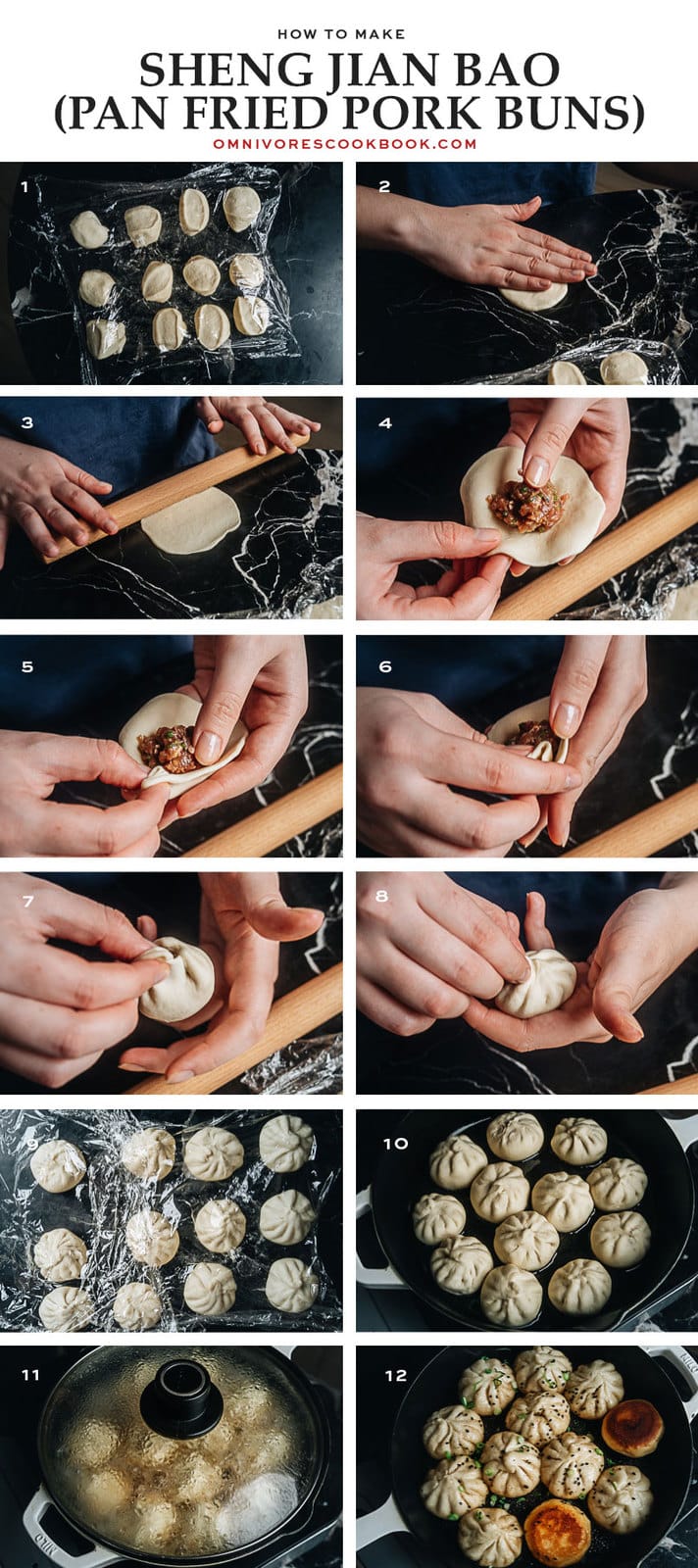
NOTE: I recommend serving the buns immediately after cooking, so the filling will be extra soupy. If you let the buns sit for a while, the juice will gradually be absorbed by the skin and lose its moisture. It will still taste delicious, but it won’t have the soup dumpling effect.
Afterthoughts
You can store your leftovers in the fridge or freezer. I like making a big batch and freezing them so my husband and I can enjoy them whenever the mood strikes!
As mentioned, in Shanghai, sheng jian bao is served for breakfast. I know the American palate is a bit different, though, so if you’re not keen on trying them for breakfast, make them as an appetizer or side dish for lunch or dinner. They’re so satisfying that you can even serve them as a main dish.
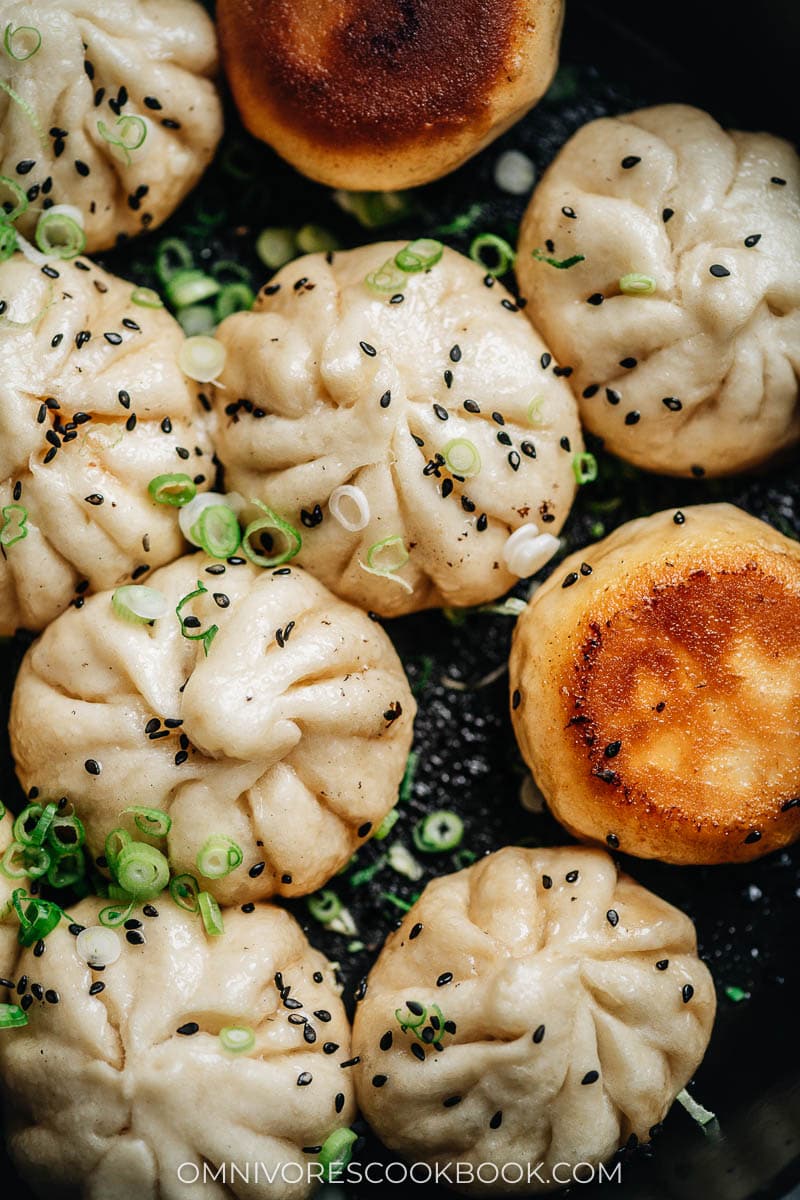
Want to learn more about Chinese Cooking? Sign up for my newsletter to receive the 5-Day Chinese Cooking Crash Course and recipe update!
Chinese Cooking Made Easy
Are you new to this website? This free email series is a great place to start. I’ll walk you through a few of my most popular recipes and show you how and why they work. You’ll quickly start to cook better Chinese food in your own kitchen.
Watch video

Sheng Jian Bao (生煎包, Shanghai Pan-Fried Pork Buns)
Ingredients
Ginger water
- 1 1/2 tablespoons ginger , minced
- 1/4 cup hot water
Dough
- 250 g (1 2/3 cup) all-purpose flour
- 50 g (1/3 cup + 1 tablespoon) cornstarch
- 4 g (3/4 teaspoon) instant yeast
- 5 g (1 teaspoon) sugar
- 150 g (2/3 cup) warm water (*Footnote 1)
- 15 g (1 tablespoon) vegetable oil
Filling
- 8 oz (227 g) ground pork (*Footnote 2)
- 1 1/2 teaspoons light soy sauce
- 1/2 teaspoon dark soy sauce (or soy sauce) (*Footnote 3)
- 2 teaspoons Shaoxing wine
- 1/2 teaspoon salt
- 1/4 teaspoon sugar
- 1/4 teaspoon ground white pepper
- 4 green onions , sliced
- 1 tablespoon toasted sesame oil
Cooking & Garnish
- 4 tablespoons vegetable oil
- 1/2 cup hot water , separated
- Chopped green onions , for garnish (Optional)
- Roasted sesame seeds , for garnish (Optional)
Instructions
Prepare ginger water
- Combine the minced ginger and hot water in a small bowl. Stir to mix well and set aside.
Prepare the dough
- In a large tall plate or a big bowl, combine the all-purpose flour, cornstarch, instant yeast and sugar. Stir to mix well.
- Slowly pour in the warm water, a few tablespoons at a time, and mix with a pair of chopsticks (or a fork). Once all the water has been added, keep mixing and scrape off the dry flour on the side of the bowl, until it forms many small dough flakes.
- Pour in the vegetable oil. Keep mixing with the chopsticks until the oil is absorbed.
- Start kneading by hand while further incorporating the dry flour, until there’s no dry flour left in the bowl.
- Transfer the dough onto a working surface. Knead for 15 to 20 minutes, until the dough is quite smooth and elastic and there’s no dry flour left in the bowl. It’s OK if there’s some unevenness in the dough, which will smooth out after resting. The dough should be quite tough and not sticky to the touch. Cover and seal the bowl with plastic wrap. Let rest until it doubles in size, 1 hour or so.
Prepare the filling
- Add the ginger water, light and dark soy sauce, Shaoxing wine, salt, sugar, and white pepper to the ground pork in a large bowl. Beat with a pair of chopsticks or a wooden spatula in a circular motion, until all the liquid is absorbed and the meat is sticky. This process might take a few minutes. (*Footnote 4)
- Add the green onions and sesame oil. Mix until they are incorporated. Cover the bowl with plastic wrap. Store in the fridge until ready to use.
Assemble the buns
- When the dough has rested, transfer to a work surface and punch it down. Knead for 1 minute to deflate the air out completely, then form it back into a ball.
- Cut the dough in half. Wrap half of the dough in plastic wrap and store in the fridge while working on the other half.
- Poke a hole in the center of the dough you’re working with. Stretch the dough into a large oval by running your fingers along the inside of the hole in a circular motion. Once the diameter of the dough is about 1” (2.5 cm), tear apart the ring so it creates a long, thin strip.
- Cut the dough strip into 12 even pieces by cutting it in half, then further cut each half into 6 pieces. Gently use a circular motion to round up each dough piece then flatten it with your palm. Cover them with plastic wrap to prevent drying out.
- Work on one piece of dough at a time – take one dough piece and place in front of you. Roll it with a rolling pin in one hand, using the other hand to rotate the dough while rolling, until the diameter reaches 5” (13 cm). You should keep the edges thinner than the center, so the wrapper of the bun will be even once you make the pleats.
- Place the rolled dough in your palm and add 1 tablespoon of filling in the center.
- Start wrapping the bun by folding and pinching the edge over itself, in one direction, until it is almost sealed. Then rotate and pinch the top of the pleats to fully seal the bun. (View my video for more details)
- Repeat with the remaining dough pieces to wrap all the buns. Keep the wrapped buns under a piece of plastic wrap to prevent drying out. Once done wrapping, let rest for 10 minutes. Once rested, you should cook the buns immediately. You can store the wrapped buns in a sealed container in the fridge for up to 1 hour before cooking.
- Repeat the wrapping steps to wrap the other half of the dough.
To cook the buns:
- Add 2 tablespoons of oil and carefully place 12 wrapped buns into a 9” or 10” skillet. Heat over medium-high heat until hot. Turn to medium heat. Cook, uncovered, for 3 minutes, until the bottoms are lightly browned.
- Pour about 1/4 cup hot water into the pan, just enough to cover the buns halfway up. Cover the pan and cook over medium heat for about 8 minutes, until the water is completely evaporated.
- Turn the heat to medium-low and cook for another 2 to 3 minutes. Turn the heat off and remove the pan from the stove. Let the buns rest with the lid on for an additional 2 minutes. Remove the lid and transfer to a plate. Repeat the steps to cook the rest of the buns.
- Serve hot immediately. (*Footnote 5) Or you can store the cooked buns in an airtight container in the fridge for up to 4 days or in the freezer for up to 3 months.
Notes
- The water should be slightly warmer than your body temperature.
- Although you can use any type of ground pork, a fattier one (e.g. 30% fat) will produce a juicier result.
- Dark soy sauce adds color to the filling, giving it the darker and more appetizing look once cooked. You can use soy sauce to replace dark soy sauce as well, but the color of the filling will come out lighter.
- It’s important to beat the filling really well, so the meat will absorb all the liquid and bind together. Once done, the meat will be easily formed into balls for the wrapping process. And once cooked, the liquid will release and create a juicy filling.
- The buns will be VERY juicy right after cooking. However, because the dough is very fluffy and it absorbs the juice fast, the buns will have less juice if you do not serve them immediately. The buns will still taste very delicious this way.
Nutrition

Did you make this recipe?
I’d love to hear how it turned out for you! Please take a moment to leave a 5-star rating ⭐️ and share your thoughts in the comments further down the page. It really helps others discover the recipe too.
If you give this recipe a try, let us know! Leave a comment, rate it (once you’ve tried it), and take a picture and tag it @omnivorescookbook on Instagram! I’d love to see what you come up with.
Other dumplings and buns recipes
- Gua Bao (Taiwanese Pork Belly Buns, 割包)
- Baked BBQ Pork Buns (Char Siu Bao)
- Chinese Steamed Custard Buns (nai wong bao, 奶黄包)
- Addictive Kimchi Pork Steamed Bun
- Chinese Pork Belly Bun (Rou Jia Mo, 肉夹馍)
Lilja Walter is a part of the Omnivore’s Cookbook team and worked closely with Maggie to develop and test this recipe.

Harriet Jane
Hello! I want to prepare this in advance. Can I fill the dough with the meat mixture, freeze it immediately, and then cook it directly from the freezer when I’m ready to eat? Or do I need to assemble the meat and dough, cook it first, and then freeze it?
Maggie Zhu
I think the “cook first, freeze later” method is less risky. When you freeze the buns, it will affect the yeast and the buns might not rise properly when you cook them.
That’s why you will find most of the packaged freezer buns are cooked, while dumplings are uncooked (no yeast needed so it’s OK to freeze raw).
Lu
My friends and I loved them 😊 thank you!
I’m not used to making dough so it teared a bit when making a circle and smaller pieces, but they turned out great nonetheless
Nats
Hi! I love this recipe and have made it a few times now! However I’m looking to make them as part of a bigger meal for a larger group of people, can you suggest any sides or recipes that would go well with it? Would a soup of some sort be appropriate? Many thanks!
Maggie Zhu
So happy to hear you like the recipe!
Yes, soup is one of the best dishes to go with buns.
A very simple soup like egg drop soup will work: https://omnivorescookbook.com/chinese-egg-drop-soup/ or https://omnivorescookbook.com/tomato-egg-drop-soup/
If you want to stick to the theme of Shanghai cuisine, this soup is perfect: https://omnivorescookbook.com/chinese-fish-soup/
Light veggie cold dishes are great too:
https://omnivorescookbook.com/ginger-green-beans/
https://omnivorescookbook.com/recipes/chinese-spinach-and-peanut-salad
https://omnivorescookbook.com/spicy-eggplant-salad/
Not sure how big a meal you’re planning, but if you need a main dish:
https://omnivorescookbook.com/cashew-chicken/
https://omnivorescookbook.com/braised-chestnut-chicken/ (this one is great because you can make ahead and heat up later)
E Zhao
I made this recipe using Impossible ground beef and it turned out really well! Since I like the filling very ginger-y, the meat substitute is not that noticeable. In terms of Impossible meat, it’s hard to get the filling juicy so I would add some gelatin to the filling to help with that.
Hanna
Hi i wanted to ask if theres anything i can put instead of meat 🙂
Maggie Zhu
It’s hard to adapt this recipe directly into a vegetarian recipe but I highly recommend looking at:
Vegetable dumplings: https://omnivorescookbook.com/vegan-dumplings/
Chive and eggs pockets: https://omnivorescookbook.com/chinese-chive-pockets/
And if you prefer the form of the pan fried buns, you can use one of those fillings and the dough from this recipe.
Genny Williams
Made these for dinner tonight and they were absolutely delicious. Devoured by all. My dumpling wrapping could use some work, but this is definitely a keeper recipe. Thank you!
Carol
Hi, how do you heat up the buns after freezing it?
Maggie Zhu
The best way is to thaw the buns in the fridge, then heat them up in a frying pan – pour in a bit water and cover the pan, so the steam will heat through the buns. Then uncover the pan, drizzle a bit oil, and let the buns cook for a bit longer to crisp up the bottom.
Barbara
What a great recipe, very yummy! Twelve were enough for one meal for my husband and me, so we will be having the second batch as a second meal, or maybe snacking! I used a pound of pork, not thinking, so I had some leftover, but not that much, just enough for a stir-fry meal. I think I could have used more than a tablespoon in each one. I used a tablespoon scoop, so next time I will be using a slightly larger scoop and hopefully use up the whole pound. The dough was perfect, the pieces rolled thin and were nice and stretchy. I did use my stand mixer and dough hook, so maybe kneading it more created the stretchiness? Who knows! The dumplings were nice and fluffy!
Barbara
Look forward to making these. I can taste them already! Have made steamed buns quite often, didn’t know I could fry them!
Sarah Peach
My friend and I just made these, and had our doubts in our cooking abilities and our comprehension of the steps. But we just finished them and are SHOCKED we made something so good! Absolutely amazing! We doubled the recipe cuz we had a pound of pork but it worked out perfectly!! Soooo good! Will definitely make again someday!
Kadiata Kaba
I adoreeeeee this recipe it reminds me so much of the sheng jian boa we got back in China I love it definitely and all time fav!
Kadiata Kaba
sorry forgot to rate it 😉
Sigrid
I’ve missed pork buns since moving to Finland. These are amazing, and not to hard either!
Kristella
This was an awesome recipe to try! Great seasoning for the filing. However, as a beginner (and doubling the recipe for 1 lbs of ground pork), this did take me about 4-5 hours from start to finish. Just a heads up to anyone trying this for the first time! Plan your day accordingly!
Jeanne S
I haven’t tried this recipe yet because I’m gluten intolerant. Can a gluten-free flour such as King Arthur’s or Einkorn create the same bun? My concern is the “fluffiness” of the buns and that gluten-free flour might not work.
Maggie Zhu
I’ve never tried to use a gluten-free flour but I’m afraid it won’t work. This is a bread recipe and it requires to work with gluten to create the texture. For gluten free flour, you probably need to use baking soda and / or baking powder, which is a totally different formula.
wooliqun
was super juicy and yummy! Thanks for the tipp!
Yung
Hubby and I love Zheng jian baos! Do you think it would be possible to make the dough, meat mixture, assemble them, and fry them the next day?
Maggie Zhu
I definitely do not recommend assemble them ahead of time. The filling will release liquid (because of the salt), which makes the dough soggy and can easily break apart during cooking. If you pre-made the dough, it might be possible to store it in the fridge to slow the rising process, then work on the assemble the next day. Although I have not tested it. But once you assemble them, it’s the best to cook them as soon as possible. You can always assemble and cook the buns, then reheat them later. The buns will be less juicy (since the dough will absorb them), but the texture and the taste of the buns will still be good the next day.
Anna
Loved this recipe! I made the dough in my stand mixer on stir and let it go for a few minutes until it was a cohesive ball. The dough was so easy to work with after proofing.
I used ground turkey to accommodate my in-laws, and they came out delicious!
Thank you for all the wonderful and reliable recipes. They’ve been a comfort during the pandemic, especially when I’m nostalgic for my childhood foods.
Val
This looks awesome! Would ground beef or dark meat ground chicken work?
Maggie Zhu
Yes! I think ground beef works slightly better but dark meat ground chicken should work as well.
Karen
This looks amazing. I am going to try it! Would store made pizza dough work instead of making the dough from scratch? Thank you.
Maggie Zhu
That is an interesting question. I’ve never tested it so I’m not 100% sure, but I think pizza dough might work.
The buns will probably come out chewier than it should be, becauase pizza dough has a higher gluten ratio. But it should rise during the cooking and create a crispy surface.
If you decided to try it out, I’d love to hear your result. But if you have the time, I would recommend to make the dough from scratch for the best texture.
Gladmama
These were excellent, we made them last night. I think next time I will roll the dough to be thicker, I like biting into a thicker bao dough. I doubled both the meat and dough recipe to accomodate 1 lb of pork.